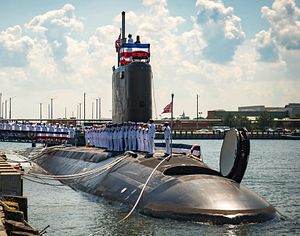Last weekend, the U.S. Navy commissioned its latest Virginia-class nuclear attack submarine, the USS John Warner (SSN-785) at a naval base in Norfolk, Virginia, CNN reports.
Chief of Naval Operations Admiral Jonathan Greenert delivered the keynote address at the commissioning ceremony, underlining the preeminence of U.S. naval power:
This boat is the latest incarnation of American sea power, and is a strategic asset for this country. This affords us what we refer to as global access, and it is fundamental to any mission that you ask your military to do. Frankly, we are challenged in space, we are challenged in cyber, we are challenged in the air, and we are challenged on the surface. We are not currently challenged in the undersea. We own the undersea domain. We must keep that situation as we go into the future.
The Virginia-class submarines are being built in block increments, with Block I and Block II already delivered to the U.S. Navy. The 114.8 meter (376.6 feet) long, 7,925-ton USS John Warner is the second of eight Block III Virginia-class submarines built with the new Virginia Payload Modules (VPM) – larger tubes that increase the ship’s missile-firing payload possibilities (See: “US Subs Getting Fire Power Boost”).
“The first 10 Block I and Block II Virginia-class submarines have 12 individual 21-inch diameter vertical launch tubes able to fire Tomahawk Land Attack Missiles (TLAMS). The Block III submarines are built with two-larger 87-inch diameter tubes able to house six TLAMS each,” the U.S. Navy website explains.
In addition, the $2.5 billion vessel sports four torpedo tubes – two on each side – armed with MK48 torpedoes. IHS Jane’s Defense Weekly notes that Virginia-class boats are “designed with a dry deck shelter capability as well as an integral lock-out trunk and reconfigurable torpedo room to accommodate special operations forces and equipment.”
In comparison to Block I and II ships, Block III vessels also contain “a water-backed Large Aperture Bow (LAB) sonar array that replaces the air-backed sonar sphere found in the first 10 Virginias.”
The ship, able to dive to depths of 240 meters (800 feet) and beyond, is specifically designed to fulfill the seven core competencies of the U.S. Navy’s submarine force: anti-submarine warfare; anti-surface warfare; delivery of special operations forces; strike warfare; irregular warfare; intelligence, surveillance and reconnaissance; and mine warfare. It can operate at speeds in excess of 25 knots while submerged.
Next to dispatching special operations forces, the USS John Warner will also be capable of launching underwater drones and is specifically designed to operate in littoral waters. It “is the most high-tech, it is the most lethal warship pound for pound that we have in our inventory,” according to Admiral Greenert.
As I reported before (See: “How Many Attack Submarines Does the United States Navy Need?”), the U.S. Navy is considering building three instead of two new Virginia-class attack submarines per year. The reason is simple: with older Los Angeles-class fast-attack submarines (built between 1972 and 1996) retiring at a faster pace than Virginia subs are added, the U.S. Navy will face a shortfall in the number of active vessels in the near future. The U.S. Navy is planning to acquire 48 Virginia-class submarines.

































